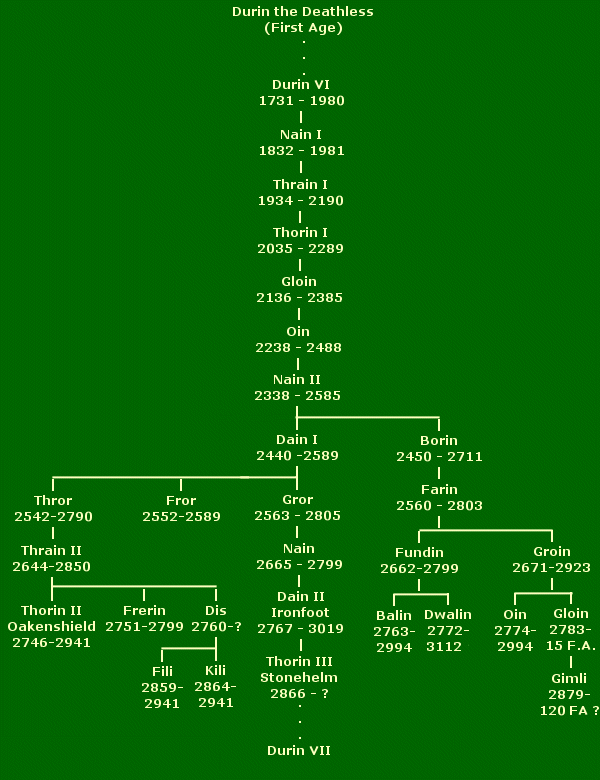

An encyclopedia of Middle-earth and Numenor

|
|
|
|
|
|
|
|
|
|
|
|
|
|
| |
|
 |

An encyclopedia of Middle-earth and Numenor |
 |

See below for a geneaology
of Durin's Folk
Around the year 260 of the First Age, Azaghal received the Dragon-helm from Telchar, a smith of Nogrod. The Dragon-helm was made shortly after the first appearance of the fire-breathing Dragon Glaurung. The visor on the Dragon-helm shielded the wearer from the Dragon's fire and enthralling gaze.
Azaghal was waylaid by Orcs while traveling along the Dwarf-road in East Beleriand. His life was saved by Maedhros, an Elf who was one of the sons of Feanor. Azaghal gave Maedhros the Dragon-helm in gratitude.
Maedhros formed an alliance to challenge Morgoth and they marched to war in 472. The Dwarves of Belegost and Nogrod made weapons in preparation for the attack and Azaghal led a force into battle.
At the Battle of Unnumbered Tears, the Dwarves of Belegost stood firm during an assault by Orcs, wolves, Balrogs, traitorous Men, and Dragons led by Glaurung. The Dwarves of Belegost wore masks that helped them withstand the Dragons' fire.
Azaghal and his Dwarves surrounded Glaurung and attacked the Dragon with their axes. Glaurung turned on Azaghal and mortally wounded him, but Azaghal managed to stab Glaurung in the belly with his last stroke. Glaurung survived but the Dragon was forced to withdraw from the battlefield and the rest of Morgoth's creatures followed him.
Azaghal died and the Dwarves of Belegost ceased fighting and sang a dirge as they carried their lord's body home.
Names &
Etymology:
The meaning of the name Azaghâl
is unknown, though some have suggested a relationship with the Adunaic
word azgarâ meaning "wage war" with Azaghâl possibly
meaning "warrior."
Sources:
The Silmarillion:
"Of the Fifth Battle," p. 189, 193
Unfinished
Tales: "Narn i Hin Hurin," p. 75, 128, 147 note 5
The History
of Middle-earth, vol. XI, The War of the Jewels: "The Grey Annals,"
p. 75
Khuzdul
- The Secret Language of the Dwarves
Bifur |
William Kircher as Bifur
|
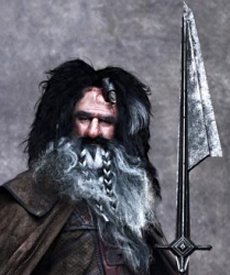 Dwarf of Thorin & Company. Bifur
was descended from the Dwarves of Khazad-dum and
was not of Durin's line. His cousins were Bofur
and Bombur. Bifur's hood was yellow and he played
the clarinet.
Dwarf of Thorin & Company. Bifur
was descended from the Dwarves of Khazad-dum and
was not of Durin's line. His cousins were Bofur
and Bombur. Bifur's hood was yellow and he played
the clarinet.
Bifur was one of the Dwarves chosen by Thorin Oakenshield for the quest to reclaim the Lonely Mountain from Smaug the Dragon. He arrived at Bag End on April 26, 2941 of the Third Age, with Gandalf, Bofur, Bombur, and Thorin. The four Dwarves fell through the door when Bilbo Baggins opened it suddenly. Bifur requested raspberry jam and apple tart from his host.
Bifur and Bombur fought especially hard when the Dwarves were captured by the Trolls Tom, Bert, and William. Bifur and Bofur remained relatively dry and secure when the Dwarves escaped from the Elvenking's Halls in barrels down the Forest River, but when Bilbo released them they lay down and did not help him.
At the Lonely Mountain, Bifur remembered that Bofur and Bombur were still outside when Smaug emerged in a rage, and his cousins were rescued. Bifur survived the Battle of the Five Armies and settled at the Lonely Mountain. He was still living there at the time of the War of the Ring. Bifur's date of death is not known.
Names &
Etymology:
Bifur, or Bívur,
is one of the dwarves named in the Old Norse poem Voluspa.
It means "trembler."
Sources:
The Hobbit:
"An Unexpected Party," p. 18-19, 21; "Roast Mutton," p. 47-49; "A Warm
Welcome," p. 206; "Inside Information," p. 230; "The Return Journey," p.
304-5
The Fellowship
of the Ring: "Many Meetings," p. 241
Appendix
A of The Lord of the Rings: "Durin's Folk," genealogical table (footnote)
The Annotated
Hobbit: "Roast Mutton, p. 77-79, note 20
Völuspá:
The Poetic Edda: Modern English translation by Bekie Marett
Bofur |
James Nesbitt as Bofur
|
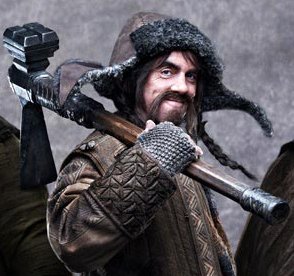 Dwarf of Thorin & Company. Bofur
was the brother of Bombur. The brothers were descended
from the Dwarves of Khazad-dum but were not of
Durin's
Line. Their cousin was Bifur. Bofur's hood was yellow
and he played the clarinet.
Dwarf of Thorin & Company. Bofur
was the brother of Bombur. The brothers were descended
from the Dwarves of Khazad-dum but were not of
Durin's
Line. Their cousin was Bifur. Bofur's hood was yellow
and he played the clarinet.
Bofur was one of the Dwarves chosen by Thorin Oakenshield for the quest to reclaim the Lonely Mountain from the Dragon Smaug in 2941 of the Third Age. At the unexpected tea party at Bag End, Bofur requested mince-pies and cheese from his host Bilbo Baggins.
Bofur tripped over a sleeping Bilbo in the house of Beorn. After Bilbo rescued the Dwarves from the Elvenking's Halls by floating them down the Forest River in barrels, Bofur and Bifur lay down and did not help Bilbo release the others.
At the Lonely Mountain, Bofur and Bombur were left to guard the ponies while the others went up to the doorstep of the secret door. Bofur was occasionally hauled up to the doorstep while another Dwarf took his place on guard duty. When Smaug emerged from the Lonely Mountain in a rage, Bofur and Bombur were rescued.
Bofur survived the Battle of the Five Armies and settled in the Lonely Mountain. He was still alive at the time of the War of the Ring. Bofur's date of death is not known.
Names &
Etymology:
Bofur
- or Bávor - is one of the Dwarves named in the Old Norse
poem Voluspa. His name means "grumbler."
Sources:
The Hobbit:
"An Unexpected Party," p. 18-19, 21; "Roast Mutton," p. 47; "Out of the
Frying-Pan into the Fire," p. 110; "Queer Lodgings," p. 134-35, 139; "Flies
and Spiders," p. 155, 173-74; "A Warm Welcome," p. 206; "On the Doorstep,"
p. 219-20; "Inside Information," p. 230; "The Return Journey," p. 304-305
The Fellowship
of the Ring: "Many Meetings," p. 241
Appendix
A of The Lord of the Rings: "Durin's Folk," genealogical table (footnote)
Völuspá:
The Poetic Edda: Modern English translation by Bekie Marett
Bombur |
Stephen Hunter as Bombur
|
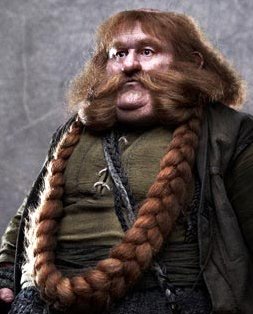 Dwarf
of Thorin & Company. Bombur was descended from the Dwarves of Khazad-dum
but was not of Durin's line. His brother was Bofur
and his cousin was Bifur. Bombur was one of the thirteen
Dwarves led by Thorin Oakenshield on the quest
to the Lonely Mountain to regain their
home and treasure from Smaug the Dragon
in 2941 of the Third Age. Bombur's hood was pale green. His instrument
was the drum.
Dwarf
of Thorin & Company. Bombur was descended from the Dwarves of Khazad-dum
but was not of Durin's line. His brother was Bofur
and his cousin was Bifur. Bombur was one of the thirteen
Dwarves led by Thorin Oakenshield on the quest
to the Lonely Mountain to regain their
home and treasure from Smaug the Dragon
in 2941 of the Third Age. Bombur's hood was pale green. His instrument
was the drum.
Bombur was exceptionally fat. His size occasionally caused problems on the quest. When he arrived at Bag End, Bilbo Baggins opened the door so suddenly that Bombur fell on top of Thorin. Bombur had difficulty running from the Orcs in the Misty Mountains, especially when he had to carry Bilbo part of the way. When Gandalf asked the Dwarves to come to Beorn's house in twos, he said that Bombur would count for two and should come last, but Bombur refused and joined the last pair.
Bombur was also picked to go last when the company prepared to cross the Enchanted Stream, but then a deer appeared suddenly and startled Bombur so that he fell into the stream and fell asleep. The Dwarves were forced to carry him through Mirkwood for several days. He finally woke up and disturbed his hungry companions by telling them about the wonderful food he had dreamed about.
When the Dwarves were captured by the Great Spiders, fat Bombur was their first choice to eat. Bilbo drove the Spiders away from Bombur with rocks and then used Sting to kill many of them.
At the Lonely Mountain, Bombur would not climb up to the secret door and stayed behind with the ponies until Smaug came roaring out of the mountain. Then Bombur was pulled up by a rope and hid in the passage with the others. When Bilbo decided to sneak away from the Lonely Mountain and make a deal with the Wood-Elves and the Lake-Men, Bombur was on guard duty but he happily agreed to let Bilbo take his place so he could sleep.
Bombur survived the Battle of the Five Armies and remained at the Lonely Mountain. When Gloin met Frodo Baggins at Rivendell in 3018, he reported that Bombur had become so fat that he could not walk and had to be carried to the table by six stout Dwarves.
Names &
Etymology:
Bombur is one of the dwarves
named in the Old Norse poem Voluspa.
His name means "fat, tubby."
Sources:
The Hobbit:
"An
Unexpected Party," p. 18; "Over Hill and Under Hill," p. 77; "Queer Lodgings,"
127, 135; "Flies and Spiders," p. 155-57, 161-62, 169, 174; "On the Doorstep,"
p. 220; "Inside Information," p. 230; "A Thief in the Night," p. 280-81
The Fellowship
of the Ring: "Many Meetings," p. 241
Appendix
A of The Lord of the Rings: "Durin's Folk," genealogical table p. 326
(footnote)
The Annotated
Hobbit: "Roast Mutton, p. 77-79, note 20
Sources:
Appendix
A of The Lord of the Rings: "Durin's Folk," p. 353 and genealogical
table p. 361
Dain I was the leader of a group of Dwarves in the Grey Mountains. The Grey Mountains were a rich source of materials which the Dwarves mined, but they were also subject to attack by Dragons from the Northern Waste. In 2589, Dain and his son Fror were killed at the doors of their hall by a great Cold-drake. Afterwards, Dain's remaining sons led their people away from the Grey Mountains. Gror went to the Iron Hills while Thror went to the Lonely Mountain.
Names &
Etymology:
Dain I was the leader of the Dwarves
of the line of Durin and as such was called the King
of Durin's Folk. He was the first King named Dain; one of his descendants
was Dain II Ironfoot.
Dain is one of the dwarves named in the Old Norse poem Voluspa.
Sources:
Appendix
A of The Lord of the Rings: "Durin's Folk," p. 353 and genealogical
table p. 361
The Annotated
Hobbit: "Roast Mutton, p. 77-79, note 20
Dáin II Ironfoot |
Decipher
card of Dain Ironfoot
|
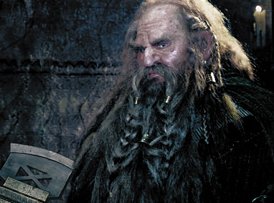 King
of the Lonely Mountain during the War
of the Ring. Dain was born in 2767 of the Third Age. He was of the
line of Durin and was the son of Nain
and the grandson of Gror, who led a company of Dwarves
to settle in the Iron Hills.
King
of the Lonely Mountain during the War
of the Ring. Dain was born in 2767 of the Third Age. He was of the
line of Durin and was the son of Nain
and the grandson of Gror, who led a company of Dwarves
to settle in the Iron Hills.
At the Battle of Azanulbizar in 2799, Nain was killed by the Orc leader Azog. Dain, who was only a young Dwarf at the time, avenged his father by cutting off Azog's head with his red axe. Dain then looked through the East-gate into Moria and became aware that Durin's Bane, the Balrog, still lurked there. Dain came away from the Gate with a look of great fear, and he counselled his cousin Thrain that the time had not yet come for the Dwarves to enter Moria.
Dain returned to the Iron Hills where he took over from his father as the leader of the Dwarves there. Among the items wrought by Dain's people were leg-coverings of fine and flexible mesh that only they knew how to make.
In 2941, Dain received a message from a raven that his cousin Thorin Oakenshield had retaken the Lonely Mountain and needed Dain's help to withstand the armies of the Men of Lake-town and the Elves of Mirkwood who were camped at the foot of the mountain. Dain marched quickly west with 500 Dwarves, and when they arrived they began advancing along the eastern arm of the Mountain. But then Gandalf appeared with the news that the Orcs and Wargs of the Misty Mountains were coming led by Bolg, son of Azog. Dain took counsel with Bard of Lake-town and King Thranduil of Mirkwood and they joined forces to defeat the Orcs in the Battle of the Five Armies.
Thorin Oakenshield was killed in battle, and Dain became King under the Mountain. He gave the Lord of the Eagles a gold crown and pledged the friendship of the Dwarves for the assistance given by the Eagles in the battle. Dain fairly dealt out the treasure of the Lonely Mountain among the surviving Dwarves and gave one-fourteenth share in gold and silver to Bard for the rebuilding of Lake-town and Dale. He also restored the Emeralds of Girion to Bard, who gave them to King Thranduil. Dain gave Bilbo Baggins a necklace of silver and pearls which the Hobbit gave to King Thranduil as well.
The Dwarves of the Lonely Mountain prospered under Dain, who was a great and wise king. But after many years some grew discontent, and Balin decided to lead a group of Dwarves to Moria in 2989, although Dain did not give consent willingly. In 3017 a messenger from Mordor came to the Lonely Mountain promising the return of three of the Seven Rings of the Dwarves in exchange for Bilbo Baggins and the One Ring he had borne. Dain sent the messenger away with no answer, but the horseman returned twice and said he would return again before the end of 3018 when he would require an answer. Dain sent Gloin and his son Gimli to Rivendell to warn Bilbo and to seek Elrond's advice.
In March of 3019, an army of Easterlings allied to Sauron attacked the Lonely Mountain and Dale. Dain and King Brand, grandson of Bard, led their people in the Battle of Dale, which lasted three days. On March 17, Brand was slain, and Dain stood over Brand's body wielding his axe until he too was killed. The Dwarves and the Men of Dale took refuge inside the Lonely Mountain until news of the victory in the south reached them and they came forth to drive the Easterlings away for good. Then Dain's son Thorin Stonehelm became King under the Mountain.
Names &
Etymology:
Dain was called
Dain Ironfoot,
possibly because the Dwarves of the Iron Hills wore iron shoes. He was
styled Dain II because he had an earlier ancestor named Dain
I. He was the King under the Mountain, meaning the Lonely Mountain.
He was also the leader of the Dwarves of the line of Durin and as such
was called the King of Durin's
Folk.
Dain is one of the dwarves named in the Old Norse poem Voluspa.
Sources:
The Hobbit:
"The Gathering of the Clouds," p. 271; "A Thief in the Night," p. 279,
283; "The Clouds Burst," p. 289-96; "The Return Journey," p. 303-4, 306
The Fellowship
of the Ring: "The Council of Elrond," p. 253-55
Appendix
A of The Lord of the Rings: "Durin's Folk," p. 353, 355-57, 359-60,
and genealogical table
Appendix
B of The Lord of the Rings: "The Tale of Years," 375-76
The Annotated
Hobbit: "Roast Mutton, p. 77-79, note 20
When Smaug the Dragon captured the Lonely Mountain from the Dwarves in 2770, Dis escaped with her father and brothers and went with them into the south where they wandered homeless for many years. They eventually settled in the Blue Mountains, where Dis gave birth to Fili and Kili. Her sons accompanied Thorin on his quest to reclaim the Lonely Mountain in 2941 and were killed during the Battle of the Five Armies.
Names &
Etymology:
The name Dis in Old Norse
signifies a female, or a nymph or goddess.
Sources:
Appendix
A of The Lord of Rings: "Durin's Folk," p. 354, 357, and genealogical
table
The
Elder Eddas and the Younger Eddas translated by I.A. Blackwell
Dori |
Mark Hadlow as
Dori
|
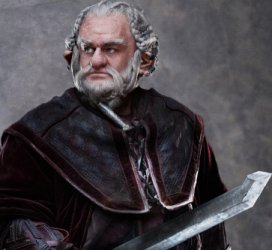 Dwarf of Thorin & Company. Dori
was of the line of Durin and was a remote kinsman
of Thorin Oakenshield. He accompanied Thorin
on the quest to reclaim the Lonely Mountain
from
Smaug the Dragon in 2941 of the
Third Age. Dori's hood was purple and he played the flute.
Dwarf of Thorin & Company. Dori
was of the line of Durin and was a remote kinsman
of Thorin Oakenshield. He accompanied Thorin
on the quest to reclaim the Lonely Mountain
from
Smaug the Dragon in 2941 of the
Third Age. Dori's hood was purple and he played the flute.
Dori was the strongest of the thirteen Dwarves in the party and he was fond of food. Dori was also quite a decent fellow. When the Dwarves escaped the captivity of the Orcs in the Misty Mountains, Dori let Bilbo Baggins climb onto his back and he carried the Hobbit into the tunnels. Later, Dori was grabbed from behind by a Orc and dropped Bilbo. Bilbo was knocked unconscious and in the ensuing confusion he was left behind. Bilbo made his way to Gollum's cave, where he found the One Ring, and escaped to be reunited with his friends.
When the company was attacked by Wargs, the Dwarves and Gandalf climbed trees but Bilbo could not reach the branches. Dori reached down to help him but Bilbo still couldn't reach, so Dori climbed down from the tree and let Bilbo stand on his back. He waited until Bilbo was safely in the tree even though the Wargs had come into the clearing. A Warg snapped at Dori's cloak as he jumped into the tree, but he was unharmed. Later when the Eagles came to their rescue, Bilbo clung to Dori's legs while an Eagle carried them both to safety.
Dori survived the Battle of the Five Armies. He remained at the Lonely Mountain and was still living there at the time of the War of the Ring.
Names &
Etymology:
Dori is one of the dwarves
named in the Old Norse poem Voluspa.
His name means "borer."
Sources:
The Hobbit:
"An Unexpected Party," p. 18, 21; "Roast Mutton," p. 41; "Over Hill and
Under Hill," p. 76, 78; "Out of the Frying-Pan and into the Fire," p. 102-103,
110-11, 117-18; "Flies and Spiders," p. 154
The Fellowship
of the Ring: "Many Meetings," p. 241
Appendix
A of The Lord of Rings: "Durin's Folk," genealogical table (footnote)
The Annotated
Hobbit: "Roast Mutton, p. 77-79, note 20
Völuspá:
The Poetic Edda: Modern English translation by Bekie Marett
The Dwarves were created in ancient times by Aule, one of the Valar. Aule was a smith and a craftsman and he wanted to teach his skills to the Dwarves. He made Durin first and then six others. But Eru had intended the Elves to be the Firstborn race so he commanded Aule to put the Dwarves to sleep until after the Elves awoke. Eru gave each of the Dwarves a lifeforce so they could exist as independent beings.
The Seven Fathers of the Dwarves were laid to rest under mountains in Middle-earth. Durin was placed beneath Mount Gundabad in the Misty Mountains. He was alone while the other six Dwarves were in pairs: the Fathers of the Firebeards and the Broadbeams slept under the Blue Mountains; the Fathers of Ironfists and the Stiffbeards were set in the East; and the Fathers of the Blacklocks and Stonefoots were in another place in the East.
The Elves awoke around 1050 of the Years of the Trees. Durin and the other Dwarves awoke some time afterwards. According to one source (HoME XI, p. 212), it was when the Elves crossed the Sea to the Undying Lands which was around 1132 of the Years of the Trees.
Durin was the first of the Seven Fathers to awake. He travelled south to the valley of Azanulbizar and looked into Mirrormere where he saw a crown of stars above his reflection. The Crown of Durin could afterwards be seen by those who looked in the waters of Mirrormere. A crown surmounted by seven stars, along with a hammer and anvil, became Durin's emblems.
Durin founded the great realm of Khazad-dum under the mountains near Azanulbizar. His people were known as Durin's Folk. It is not clear how these other Dwarves originated. In most accounts, Durin was the only one of the Seven Fathers not to be paired with a mate upon his creation, but since he was the progenitor of the Kings of Durin's Folk it seems he must have found a mate at some point. One note suggests that Durin gathered Dwarves from other kindreds while another proposes that more Dwarves were created to awake with the Seven Fathers.
Durin died some time before the end of the First Age. The length of his life is unknown. Between the awakening of the Elves and the end of the First Age was about 4,900 years. (The Years of the Trees ended around 1500 and each year was comparable to 9.582 solar years. The First Age lasted about 590 years.) So Durin may have lived for several thousand years whereas the normal Dwarf lifespan was around 250 years.
Durin I was the first of a long line of Kings of Durin's Folk that lasted until at least the Fourth Age. The Dwarves believed that Durin's spirit was periodically reborn in the Kings that bore his name and that these other Durins bore his likeness and his memories. The last of these was Durin VII.
Names &
Etymology:
Durin I was the first King
of Durin's Folk and the first
King of Khazad-dum. Since the
Dwarves did not reveal their true names to outsiders, the name
Durin
was apparently a word meaning "king" chosen from the language of the Men
of northern Middle-earth. Durin is one of the dwarves named in the
Old Norse poem Voluspa. His name means
"sleepy."
He was called Durin the Deathless because of his long lifespan and because his spirit was believed to have returned in the Kings bearing his name.
Sources:
The Hobbit:
"A Short Rest," p. 63
The Fellowship
of the Ring: "A Journey in the Dark," p. 318-19, 329-30; "Lothlorien,"
p. 348
Appendix
A of The Lord of the Rings: "Durin's Folk," p. 352 and passim
The Silmarillion:
"Of Aule and Yavanna," passim
The History
of Middle-earth, vol. XI, The War of the Jewels: "The Grey Annals,"
p. 5, 7-10, 29-30; "The Later Quenta Silmarillion - Concerning the Dwarves,"
p. 201-15
The History
of Middle-earth, vol. XII, The Peoples of Middle-earth: "The Making
of Appendix A," p. 275-79; "Of Dwarves and Men," p. 301, 304, 322 note
24; "Last Writings," p. 382-84
The Letters
of J.R.R. Tolkien: Letter #212
Völuspá:
The Poetic Edda: Modern English translation by Bekie Marett
Durin III |
Decipher
card of Durin III
|
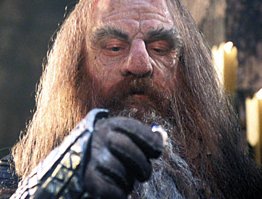 First
Dwarf to receive one of the Seven Rings.
Durin III was the King of Khazad-dum during 1600s
of the Second Age. His father's name is not known. He was named after his
ancestor, Durin I, who was the eldest of the Seven
Fathers of the Dwarves. The Dwarves believed that Durin I's spirit and
memories lived on in the descendants who bore his name.
First
Dwarf to receive one of the Seven Rings.
Durin III was the King of Khazad-dum during 1600s
of the Second Age. His father's name is not known. He was named after his
ancestor, Durin I, who was the eldest of the Seven
Fathers of the Dwarves. The Dwarves believed that Durin I's spirit and
memories lived on in the descendants who bore his name.
The Dwarves of Khazad-dum were friendly with the Elves of nearby Eregion. The Rings of Power were forged by the Elven-smiths of Eregion during the 1500s with the help of Sauron, who had deceived them about his identity. According to Dwarf legend, the first of the Seven Rings was given to Durin III by the Elves.
In 1697, Sauron invaded Eregion to seize the Rings of Power. Durin III sent out an army of Dwarves from Khazad-dum, allowing Elrond and the surviving Elves to escape. The Dwarves then retreated into Khazad-dum and shut the Doors of Durin. Sauron's forces could not pursue them, and the Dwarves earned Sauron's hatred.
Sauron obtained the remaining six of the Seven Rings and distributed them to the other Dwarf-lords. Although Durin III had received his Ring directly from the Elves, it was still tainted because Sauron had helped make it. The Dwarves who bore the Seven Rings resisted the domination of Sauron, but they became greedy and valued the acquisition of wealth above all.
Durin III passed the Ring to his descendants until it came to Thrain II. Sauron captured Thrain II and took the Ring from him.
Names &
Etymology:
Durin III was the third King
named Durin. He was the
King of Khazad-dum. He was also the leader
of the Dwarves of the line of Durin and as such was called the King
of Durin's Folk.
Since the Dwarves did not reveal their true names to outsiders, the name Durin was apparently a word meaning "king" chosen from the language of the Men of northern Middle-earth.
Durin is one of the dwarves named in the Old Norse poem Voluspa. His name means "sleepy."
Sources:
Appendix
A of The Lord of Rings: "Durin's Folk," p. 352, 357
Unfinished
Tales: "The History of Galadriel and Celeborn," p. 238
The History
of Middle-earth, vol. XII, The Peoples of Middle-earth: "Of Dwarves
and Men," p. 304; "Last Writings," p. 382-83
Völuspá:
The Poetic Edda: Modern English translation by Bekie Marett
In 1980, the Dwarves of Khazad-dum were mining for mithril deep below Caradhras when they encountered a Balrog. The Balorg had slept beneath the mountain since the end of the First Age. It may have been roused by the Dwarves, or it may have awakened in response to the growing power of Sauron in Middle-earth.
Durin VI was killed by the Balrog, which was known to the Dwarves thereafter as Durin's Bane. Durin VI was succeeded by his son Nain I, but he too was killed the next year in 1981 and the Dwarves abandoned Khazad-dum.
Names &
Etymology:
Durin VI was the sixth King
named Durin. He was named after Durin I, who was the eldest of the Seven
Fathers of the Dwarves and the forefather of the Longbeards. Durin VI was
the
King of Khazad-dum. He was also the leader of the Dwarves of
the line of Durin and as such was called the King
of Durin's Folk.
Since the Dwarves did not reveal their true names to outsiders, the name Durin was apparently a word meaning "king" chosen from the language of the Men of northern Middle-earth.
Durin is one of the dwarves named in the Old Norse poem Voluspa. His name means "sleepy."
Sources:
Appendix
A of The Lord of Rings: "Durin's Folk," p. 352-53 and genealogical
table
The History
of Middle-earth, vol. XII, The Peoples of Middle-earth: "Of Dwarves
and Men," p. 304; "Last Writings," p. 382-83
Völuspá:
The Poetic Edda: Modern English translation by Bekie Marett
It is not known exactly when Durin VII lived but it was apparently sometime during the Fourth Age. He originally ruled at the Lonely Mountain. Durin VII decided that the time was right for the Dwarves to reclaim their greatest realm.
Khazad-dum had been abandoned in 1981 of the Third Age after the Balrog killed Durin VI and Nain I. It became a place of evil inhabited by Orcs and other creatures and was known as Moria, the Black Pit. The Balrog was killed during the Battle of the Peak with Gandalf in 3019 but the Dwarves did not immediately return to Khazad-dum.
Durin VII restored Khazad-dum to its former glory. Work began again in the mines and forges and the halls were filled with light and music. The realm of Khazad-dum endured until the race of Dwarves dwindled. Durin VII's descendants continued to rule Khazad-dum but there was never again a King named Durin.
Names &
Etymology:
Durin VII was called "the
Last" because he was the last King named after Durin I. He was the
King
of Durin's Folk. When he ruled at the Lonely Mountain, Durin VII
was
King under the Mountain. He then became the King of Khazad-dum.
Since the Dwarves did not reveal their true names to outsiders, the name Durin was apparently a word meaning "king" chosen from the language of the Men of northern Middle-earth.
Durin is one of the dwarves named in the Old Norse poem Voluspa. His name means "sleepy."
Sources:
Appendix
A of The Lord of Rings: "Durin's Folk," genealogical table
The History
of Middle-earth, vol. XII, The Peoples of Middle-earth: "The Making
of Appendix A," p. 278-79; "Of Dwarves and Men," p. 304; "Last Writings,"
p. 382-83
Völuspá:
The Poetic Edda: Modern English translation by Bekie Marett
Dwalin |
Graham McTavish as Dwalin
|
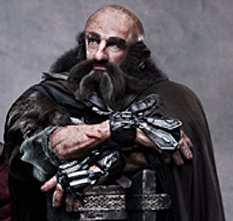 Dwarf of Thorin & Company. Dwalin,
son of Fundin, was born in 2772 of the Third Age.
His older brother was Balin. Their familiy was
of the line of Durin. Dwalin had a blue beard and
bright eyes. He wore a dark green hood and he played the viol.
Dwarf of Thorin & Company. Dwalin,
son of Fundin, was born in 2772 of the Third Age.
His older brother was Balin. Their familiy was
of the line of Durin. Dwalin had a blue beard and
bright eyes. He wore a dark green hood and he played the viol.
In 2841, Thorin Oakenshield's father Thrain decided to try to reclaim the Lonely Mountain from Smaug the Dragon. Dwalin and Balin were among the Dwarves who went with him. They were pursued by the minions of Sauron, who sought the Ring of the Dwarves borne by Thrain. One night while camping in the eaves of Mirkwood in 2845, Thrain was captured and taken to Dol Guldur. Balin and Dwalin and the other Dwarves sought him in vain.
One hundred years later in 2941, Thorin renewed the quest for the Lonely Mountain, and Dwalin was chosen as one of the twelve Dwarves to accompany him. Dwalin was the first Dwarf to arrive at the home of Bilbo Baggins on April 26, and he sat down for tea with his host until the others arrived. Afterwards he helped clean up the dishes. When Bilbo embarked on the quest the next morning without a hat, Dwalin lent him a dark green hood.
After Bilbo rescued the Dwarves from the Great Spiders of Mirkwood, Dwalin was the first to notice that Thorin was missing. Later, when Bilbo helped them escape from the prison of the Elvenking using barrels floating down the Forest River, Dwalin was one of the worst affected by the journey. While they tried to find the secret door at the Lonely Mountain, Dwalin expressed his impatience with their burglar.
Dwalin settled at the Lonely Mountain after Smaug's demise and became prosperous. When his brother Balin led an ill-fated expedition to Moria in 2989, Dwalin remained at the Lonely Mountain. He was still living there at the time of the War of the Ring.
On the genealogical table in Appendix A of The Lord of the Rings, Dwalin's date of death is given as 3112. This is unusual for two reasons. Firstly, there was no such year as 3112 since the Third Age ended with the year 3021. (This date would correspond to the year 91 of the Fourth Age.) Secondly, this would have made Dwalin about 340 years old when he died, which is extremely old for a Dwarf. One draft of the genealogical table seems to suggest that Dwalin was 251 when he died, which would make his date of death around the year 2 of the Fourth Age.
Names &
Etymology:
Dwalin, or Dvalin,
is one of the dwarves named in the Old Norse poem Voluspa.
His name means "dawdler."
Sources:
The Hobbit:
"An Unexpected Party," p. 15-17, 19, 21-22; "Roast Mutton," p. 39, 47;
"A Short Rest," p. 58; "Out of the Frying-Pan Into the Fire," p. 110; "Queer
Lodgings," p. 132-33; "Flies and Spiders," p. 155-56, 165, 178; "A Warm
Welcome," p. 206; "On the Doorstep," p. 221; "The Return Journey," p. 304
The Fellowship
of the Ring: "Many Meetings," p. 241
Appendix
A of The Lord of Rings: "Durin's Folk," 358 and genealogical table
The Annotated
Hobbit: "Roast Mutton, p. 77-79, note 20
The History
of Middle-earth, vol. XII, The Peoples of Middle-earth: "The Making
of Appendix A," p. 288 note 17
Völuspá:
The Poetic Edda: Modern English translation by Bekie Marett
Source:
Appendix
A of The Lord of Rings: "Durin's Folk," genealogical table p. 361
Fíli |
Dean O'Gorman as Fili
|
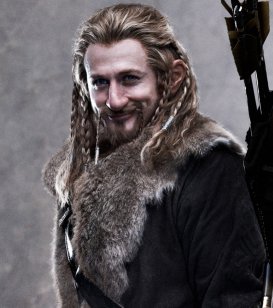 Dwarf of Thorin & Company. Fili
was born in 2859 of the Third Age. He and his younger brother Kili
were the nephews of Thorin Oakenshield. Their
mother
Dis was Thorin's younger sister. They were of
Durin's
Line. Fili had a yellow beard and a long nose and he wore a blue hood.
He played the fiddle. Fili had very sharp eyesight.
Dwarf of Thorin & Company. Fili
was born in 2859 of the Third Age. He and his younger brother Kili
were the nephews of Thorin Oakenshield. Their
mother
Dis was Thorin's younger sister. They were of
Durin's
Line. Fili had a yellow beard and a long nose and he wore a blue hood.
He played the fiddle. Fili had very sharp eyesight.
Fili and Kili were born in the Blue Mountains and lived there until 2941, when they were chosen to accompany their uncle on the quest to reclaim the Lonely Mountain from Smaug the Dragon. At the unexpected tea party at Bag End on April 26, Fili helped his host Bilbo Baggins clear away the dishes.
When the company was caught by a storm in the High Pass of the Misty Mountains, Fili and Kili found a cave to take shelter in. Unfortunately the cave turned out to be the Front Porch of a secret entrance to an Orc lair. The Dwarves and Bilbo were captured by the Great Goblin but were rescued by Gandalf. It was in the tunnels under the mountains that Bilbo found the One Ring.
In Mirkwood, Fili retrieved the boat from the far bank of the Enchanted Stream by throwing a rope with a hook on the end. The boat had no oars, so Fili came up with the idea of pulling the boat back and forth across the stream using another rope and hook.
Fili was the first Dwarf whom Bilbo freed from the webs of the Great Spiders and he helped the Hobbit free the others even though he was very ill from the poison. Afterwards, Fili had to cut off most of his beard because of the spider webs stuck in it.
Later, when the Dwarves escaped from the Elvenking's Halls by floating in barrels down the Forest River, Fili again helped Bilbo free the others. Fili had been packed in an apple barrel and he was so sick of the smell that he never wanted to eat an apple again. Fili and Kili accompanied Thorin to meet the Master of Lake-town, and they were seated in places of honor.
At the Lonely Mountain, Fili went to investigate the Front Gate with Balin, Bilbo and Kili. Fili and Kili were with Bilbo later when he found the secret entrance to the mountain. They did not accompany Bilbo into the Dragon's lair, though they felt uncomfortable about not offering. Once Smaug left the mountain, Fili and Kili found golden harps in the Dragon's hoard. The brothers were then sent to retrieve three of their escaped ponies.
When Thorin rejected Bard the Bowman's request for a share in the treasure, Fili and Kili apparently did not share their uncle's view. But during the Battle of the Five Armies, the two brothers valiantly defended Thorin with their shields and bodies. Fili and Kili were both killed and Thorin later died of his wounds.
Note:
In the text of The
Hobbit (p. 154), Thorin calls Fili the youngest of the Dwarves,
but on the genealogical table in Appendix A
of The Lord of the Rings, Kili is shown
to be younger than Fili.
Names &
Etymology:
Fíli is one of the
Dwarves named in the old Norse poem Voluspa.
His name means "file," as in the type of tool.
Sources:
The Hobbit:
"An Unexpected Party," p. 17, 19, 21, 25; "Roast Mutton," p. 41-42, 47,
53; "Over Hill and Under Hill," p. 69, 76; "Out of the Frying-Pan into
the Fire," p. 110; "Queer Lodgings," p. 133; "Flies and Spiders," p. 154-55,
172-73; "A Warm Welcome," p. 206-208, 211; "On the Doorstep," p. 216, 218;
"Inside Information," p. 225, 230; "Not at Home," p. 251; "The Gathering
of the Clouds," p. 272, 278; "The Return Journey," p. 303-304
Appendix
A of The Lord of Rings: "Durin's Folk," p. 357 note 2 and genealogical
table
Völuspá:
The Poetic Edda: Modern English translation by Bekie Marett
Source:
The Fellowship
of the Ring: "The Bridge of Khazad-dum," p. 335
Names &
Etymology:
Frár is one of the
Dwarves named in the old Norse poem Voluspa.
His name means "famous."
Source:
The Fellowship
of the Ring: "The Bridge of Khazad-dum," p. 336
Völuspá:
The Poetic Edda: Modern English translation by Bekie Marett
Frerin's grandfather Thror was slain by the Orc-leader Azog, and Frerin fought in the Battle of Azanulbizar against Azog's forces in 2799. Frerin was part of the first assault of the vanguard led by his father Thrain. The Orcs drove them into the woods near Mirrormere, and there Frerin was killed.
Source:
Appendix
A of The Lord of Rings: "Durin's Folk," p. 353-55 and genealogical
table
Source:
Appendix
A of The Lord of Rings: "Durin's Folk," p. 353 and genealogical table
At the Battle of Azanulbizar in 2799, Fundin was part of the first charge led by Thrain. The Dwarves were driven back by the Orcs to the woods near Mirrormere. Fundin was killed there along with many others, but the Dwarves eventually won the battle.
Names &
Etymology:
Fundin is one of the dwarves
named in the Old Norse poem Voluspa.
His name means "found."
Source:
The Hobbit:
"The
Gathering of the Clouds," p. 269
The Fellowship
of the Ring: "A Journey in the Dark," p. 333-34
Appendix
A of The Lord of Rings: "Durin's Folk," p. 355 and genealogical table
Völuspá:
The Poetic Edda: Modern English translation by Bekie Marett
Names &
Etymology:
He was called Gamil Zirak the
Old. The word zirak either means "silver" or "spike" in Dwarvish
and appears in the name Zirak-zigil.
Sources:
Unfinished
Tales: "Narn I Hin Hurin," p. 76
The History
of Middle-earth, vol. VII, The Treason of Isengard: "The Ring Goes
South," p. 174-75 note 22 (translation of Zirakzigil)
Note:
For Gloin,
father of Gimli, see below.
Names &
Etymology:
Gloin, or Glói,
is one of the dwarves named in the Old Norse poem Voluspa.
His name means "glow."
Gloin was the leader of the Dwarves of the line of Durin and as such was called the King of Durin's Folk.
Sources:
Appendix
A of The Lord of the Rings: "Durin's Folk," genealogical table p. 361
Appendix
B of The Lord of the Rings: "The Tale of Years," p. 368
The Annotated
Hobbit: "Roast Mutton, p. 77-79, note 20
Völuspá:
The Poetic Edda: Modern English translation by Bekie Marett
Glóin, father of GimliDwarf of Thorin & Company; father of Gimli. Gloin, son of Groin, was born in 2783 of the Third Age. His older brother was Oin. They were of the line of Durin. After the Battle of Azanulbizar in 2799, Gloin accompanied Thrain and Thorin Oakenshield in their wandering until they made their home in the Blue Mountains. Gloin's son Gimli was born in 2879.In 2941, when Thorin and Gandalf came up with a plan to retake the Lonely Mountain from Smaug the Dragon, Gloin was one of the thirteen Dwarves in the party. Gloin's hood was white. Gloin and his brother Oin proved useful on the quest because they were especially good at making fires. Gloin did not think much of their prospective burglar Bilbo Baggins at first, saying, "He looks more like a grocer than a burglar!" (Hobbit, p. 26) But as the quest proceeded and Bilbo began to show his worth, Gloin gained respect and affection for the Hobbit. After the Battle of the Five Armies, Gloin remained at the Lonely Mountain, and the Dwarves there prospered. But some grew restless, and in 2989, Balin led a group of Dwarves on an ill-fated mission to Moria. Around 3017, a messenger from Mordor came to the Lonely Mountain seeking information on Hobbits and the One Ring. Gloin and his son Gimli traveled to Rivendell in October of 3018 to warn Bilbo of the danger and to seek advice from Elrond. At Rivendell, Gloin met Frodo Baggins and attended the Council of Elrond. Gloin's son Gimli was chosen as a membership of the Fellowship of the Ring. Names &
Etymology:
Sources:
|
Peter Hambleton as Gloin
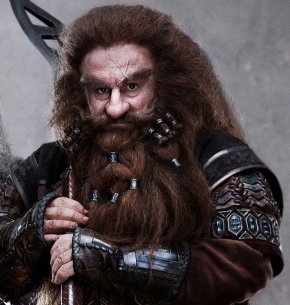 |
Source:
Appendix
A of The Lord of Rings: "Durin's Folk," genealogical table p. 361
After his father and his brother Fror were slain by a Dragon in the Grey Mountains, Gror led many followers away to the Iron Hills and established a colony there in 2590. Gror's other brother Thror settled in the Lonely Mountain and there was traffic of ore between the two colonies.
Gror's son was Nain and his grandson was Dain Ironfoot. Gror died in 2805.
Source:
Appendix
A of The Lord of Rings: "Durin's Folk," 353 and genealogical table
p. 361
Appendix
B of The Lord of Rings: "The Tale of Years," p. 368
Kíli |
Aidan Turner as
Kili
|
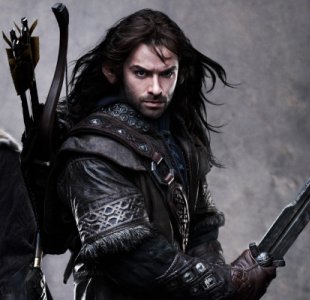 Dwarf of Thorin & Company. Kili
was born in the Blue Mountains in 2864
of the Third Age. He was of the line of Durin, and
his mother was Dis, sister of Thorin
Oakenshield. Kili had an older brother Fili. Kili's
hood was blue and he played the fiddle.
Dwarf of Thorin & Company. Kili
was born in the Blue Mountains in 2864
of the Third Age. He was of the line of Durin, and
his mother was Dis, sister of Thorin
Oakenshield. Kili had an older brother Fili. Kili's
hood was blue and he played the fiddle.
In 2941, Kili accompanied his uncle Thorin on the quest to reclaim the Lonely Mountain from the Dragon Smaug. Kili was the youngest Dwarf on the expedition and he had sharp eyesight. In the High Pass of the Misty Mountains, Kili and Fili found a cave called the Front Porch for the company to take shelter in, but though the brothers claimed to have thoroughly explored it, Orcs emerged from a hidden opening and took them all captive. It was during the flight from the Orcs deep under the mountains that Bilbo Baggins found the One Ring.
Kili was on watch in Mirkwood when he spotted the fires of the Wood-elves, but when the Dwarves approached they were taken captive. Bilbo rescued them and sent the Dwarves in barrels down the Forest River. Kili and Fili were the least affected by the trip and helped Bilbo release the others from their barrels. Kili and Fili then accompanied Thorin into Lake-town and were seated in places of honor at the Master's table when Thorin declared himself to be King under the Mountain.
At the Lonely Mountain, Kili and Fili accompanied Balin and Bilbo on the first scouting expedtion, and later the brothers were with Bilbo when he found the hidden door. As one of the more active Dwarves, Kili was frequently sent on errands from the camp high on the doorstep. After Smaug's departure, Kili and Fili played golden harps from the treasure hoard. The brothers were also sent to retrieve the ponies who had run off.
When Thorin refused to negotiate with the Lake-men and Wood-elves who came to the mountain seeking part of the treasure after Smaug's death, Kili and Fili seemed not to share their uncle's mind on the matter. Kili and Fili fought alongside Thorin when the Dwarves joined forces with the Men and Elves to fight the attacking Orcs in the Battle of the Five Armies. Thorin was mortally wounded, and Kili and Fili died defending him.
Note:
In the text of The
Hobbit(p. 154)), Thorin calls Fili the youngest of the Dwarves,
but on the genealogical table in Appendix A
of The Lord of the Ringss, Kili is shown
to be younger than Fili., Kili is shown
to be younger than Fili.
Names &
Etymology:
Kili is one of the dwarves
named in the Old Norse poem Voluspa.
His name means "wedge."
Sources:
The Hobbit:
"An Unexpected Party," p. 17, 19, 21, 25; "Roast Mutton," p. 41-42; "Over
Hill and Under Hill," p. 68-69; "Flies and Spiders," p. 165; "A Warm Welcome,"
p. 206-8, 211; "On the Doorstep," p. 216, 218, 220; "Not at Home," p. 251;
"The Gathering of the Clouds," p. 272, 278; "The Return Journey," p. 303-4;
and passim
Appendix
A of The Lord of Rings: "Durin's Folk," p. 357 note 2 and genealogical
table
The Annotated
Hobbit: "Roast Mutton, p. 77-79, note 20
Völuspá:
The Poetic Edda: Modern English translation by Bekie Marett
Names &
Etymology:
The name Lóni appears
in the Old Norse poem Voluspa. It means
"fighter."
Sources:
The Fellowship
of the Ring: "The Bridge of Khazad-dum," p. 336
Völuspá:
The Poetic Edda: Modern English translation by Bekie Marett
By the 480s of the First Age, Mim had lived to a very old age for a Dwarf. He and his sons dwelled beneath Amon Rudh - an isolated hill that the Dwarves called Sharbhund - in a hidden lair that had once housed many Petty-Dwarves. Most of the forges were idle except for a small one where Mim occasionally worked.
Around 485, Mim and his sons were out gathering edible roots when they were waylaid by Turin and his band of outlaws. Khim and Ibun fled, and an outlaw named Androg shot an arrow after them. Mim was too slow and he was captured. In exchange for his life, Mim agreed to lead Turin and the outlaws to his hidden lair as long as he was allowed to stay there with them.
Mim offered to fetch a light so they could travel by night, but the outlaws did not trust him. They tied him up overnight, which angered Mim greatly. The next day, Mim led them to Amon Rudh and up the secret paths to the hidden entrance to Bar-en-Nibin-noeg, the House of the Petty-Dwarves. Mim renamed it Bar-en-Danwedh, the House of Ransom, because he had offered it up as payment for his life.
Then Mim learned from Ibun that Khim had been struck by Androg's arrow and had died while Mim had been delayed by the outlaws. Turin felt pity for Mim and promised him a share of any gold he might acquire, and Mim was impressed that Turin behaved like a Dwarf-lord. But Mim demanded that Androg break his bow and arrows and laid a curse of death on him if he should ever use them again.
Mim shared his food with the outlaws and guided them when they left the caves, but he did not allow them in his smithy and he kept secret a hidden stairway to the summit of Amon Rudh. While Turin became friendly with Mim and listened to his stories, the other outlaws began to resent his constant presence.
In the winter, there was a blizzard and many of the outlaws became sick and hungry. Turin's friend Beleg arrived from Doriath with supplies and he used his skills to heal the sick. Mim hated Beleg because he was an Elf and he was jealous of his friendship with Turin. Mim retreated to the depths of the caves and did not speak, but Turin no longer took any notice of him.
In the spring of the next year, Morgoth began to send Orcs down from the north into West Beleriand. Turin and Beleg defended the lands around Amon Rudh which became known as the Land of Bow and Helm after Beleg's bow Belthronding and the Dragon-helm worn by Turin. Androg defied Mim's curse and took up his bow to join them. He was wounded by a poison arrow but Beleg healed him, causing Mim to hate the Elf even more.
Morgoth became aware of Turin's location and he sent spies to surround Amon Rudh. In 489, Mim encountered a company of Orcs. According to one story, Mim and Ibun were captured while out gathering roots. But according to another story, Mim deliberately set out to find Morgoth's spies in order to get rid of Beleg and the other outlaws.
Mim tried to bargain with the Orcs. He wanted his house to be returned to him after the Orcs dealt with the outlaws. He asked for a Man's weight in iron for each outlaw killed or captured and the equivalent in gold for Turin and Beleg, though he wanted Turin to be spared and Beleg left bound so that Mim could kill the Elf himself. The Orc-captain had no intention of complying with any of the requests except letting Mim deal with Beleg, but he agreed. Ibun was held hostage to ensure that Mim did not back out of the deal.
Mim was afraid but he had no choice but to guide the Orcs to his hidden lair. Turin and some of his followers held out for a time on the summit of Amon Rudh, but soon the outlaws were slain and Turin was taken captive. The Orcs defiled and ravaged Mim's home and departed with their prisoner while Mim hid in his caves.
Beleg had been left behind, bound and pinned to the summit. Mim gloated and prepared to kill Beleg. But according to one account, Androg managed to drive Mim away with a sword though the outlaw had been mortally wounded by the Orcs.
Mim descended Amon Rudh by a steep path and fled. It is not known whether the Orcs freed Ibun or slew him when they left, but apparently he died at some point and Mim was left alone as the last of the Petty-Dwarves.
Beleg tracked Turin, but Turin mistook Beleg for one of his captors and killed him. Turin went to Nargothrond, which was captured by Glaurung the Dragon in 495. In 499, Glaurung left Nargothrond and was slain by Turin, but not before the Dragon revealed that Turin had unknowingly married his sister Nienor. Turin and Nienor both committed suicide.
Mim made his way to Nargothrond in 499 after Glaurung departed and reclaimed the halls once occupied by his people. No one else dared approach, and Mim took possession of the Dragon's hoard of gold and gems.
Around 502, Turin's father Hurin came to Nargothrond after being released from captivity by Morgoth. Hurin was aware of all the tragedies that had befallen his son and he blamed Mim for betraying Turin. Mim begged for his life, but Hurin slew him and took the Nauglamir from the hoard and departed.
Names &
Etymology:
The name of the character Mîm
is probably derived from Mímir,
a figure in Norse mythology whose name means "the rememberer, the wise
one" in Old Norse.
Sources:
The Silmarillion:
"Of Turin Turambar," p. 202-206; "Of the Ruin of Doriath," p. 230
Unfinished
Tales: "Narn I Hin Hurin," p. 96-104, 147 note 6, 148 notes 16-19,
150-52, 154
The Children
of Hurin: "Of Mim the Dwarf," passim; "The Land of Bow and Helm," passim
The History
of Middle-earth, vol. XI, The War of the Jewels:"The Later Quenta
Silmarillion," p. 180; "The Wanderings of Hurin," p. 255, 257-58, 299 note
8"The Later Quenta
Silmarillion," p. 180; "The Wanderings of Hurin," p. 255, 257-58, 299 note
8
In 2799, Nain fought against the Orcs in the Battle of Azanulbizar. He arrived late with fresh troops and led them through the thick of battle all the way to the gates of Moria. Nain challenged the Orc leader Azog to come out and they fought together on the steps. Azog broke Nain's neck and killed him. Nain's son Dain avenged his father and slew Azog.
Sources:
Appendix
A of The Lord of Rings:"Durin's Folk," 355-56 and genealogical table
p. 361"Durin's Folk," 355-56 and genealogical table
p. 361
Names &
Etymology:
Nain I was the King of the Dwarves
of Khazad-dum. He was also the leader of the Dwarves of the line of Durin
and as such was called the King of Durin's Folk. He was the first
King of that name.
Sources:
Appendix
A of The Lord of Rings:"Durin's Folk," p. 353, and genealogical table
p. 361"Durin's Folk," p. 353, and genealogical table
p. 361
Names &
Etymology:
Nain II was the leader of the Dwarves
of the line of Durin and as such was called the King
of Durin's Folk. He was the second King of that name.
Sources:
Appendix
A of The Lord of Rings: "Durin's Folk," p. 353, and genealogical table
p. 361
Names &
Etymology:
Náli is one of the
Dwarves named in the old Norse poem Voluspa.
His name means "corpse."
Source:
The Fellowship
of the Ring: "The Bridge of Khazad-dum," p. 336
Völuspá:
The Poetic Edda: Modern English translation by Bekie Marett
Thror and Nar came to Moria in 2790 of the Third Age. Despite Nar's warning, Thror entered Moria through the East-gate. Nar waited for him in the Dimrill Dale for several days. Then Nar heard a shout and a horn blast, and Thror's body was thrown from the gate. Thror had been decapitated, and his forehead was branded with the name Azog, the Orc-leader of Moria.
Azog called to Nar and told him to deliver a message to the Dwarves that if any of them tried to reclaim Moria they would be killed. Nar tried to take Thror's body, but Azog stopped him. He called Thror a thief and Nar a beggar, and he threw Nar a small bag of coins as an insult.
Nar returned to his people and told Thror's son Thrain II what had happened. As a result, the War of the Dwarves and the Orcs began. Azog was eventually defeated by the Dwarves, but they did not reclaim Moria at that time because the Balrog still lurked there.
Names &
Etymology:
Nár is one of the
Dwarves named in the old Norse poem Voluspa.
His name means "corpse."
Sources:
Appendix
A of The Lord of Rings: "Durin's Folk," 354-55
Völuspá:
The Poetic Edda: Modern English translation by Bekie Marett
Sources:
The Fellowship
of the Ring: "A Journey in the Dark," p. 318
Unfinished
Tales: "The History of Galadriel and Celeborn," p. 235
NoriDwarf of Thorin & Company. Nori was of the line of Durin and was a remote kinsman of Thorin Oakenshield. His hood was purple and he played the flute. Nori was fond of regular and plentiful meals.In 2941 of the Third Age, Nori was selected to accompany Thorin on the quest to reclaim the Lonely Mountain from Smaug the Dragon. When the company was forced to climb trees to avoid a pack of Wargs, Nori pointed out to Dori that Bilbo had been left behind. Nori survived the Battle of the Five Armies and settled at the Lonely Mountain. He was still alive at the time of the War of the Ring. His date of death is not known. Names &
Etymology:
Sources:
|
Jed Brophy as Nori
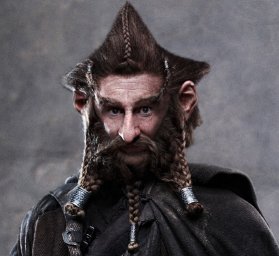 |
Oin lived in the Grey Mountains. He succeeded his father as the leader of their people in 2385. Oin died in 2488 and was followed by his son Nain II.
Names &
Etymology:
Óin (or Óinn)
is one of the Dwarves listed in the Younger Edda,
also called
Snorre's Edda or the Prose
Edda. The name may mean "shy."
Oin was the leader of the Dwarves of the line of Durin and as such was called the King of Durin's Folk.
There was also a Dwarf named Oin in Thorin's Company.
Sources:
Appendix
A of The Lord of the Rings: "Durin's Folk," genealogical table p. 361
The
Lord of the Rings Dictionary
The
Prose Edda (full text online)
Óin (II)Dwarf of Thorin & Company. Oin was born in 2774 of the Third Age. He was the son of Groin and the older brother of Gloin. They were of the line of Durin. Oin was a member of the company of thirteen Dwarves formed by Thorin Oakenshield in 2941 to reclaim the treasures of the Lonely Mountain from Smaug. Oin's hood was brown. Like his brother Gloin, Oin was skilled at making fires using a tinder-box. Oin survived the Battle of the Five Armies and settled at the Lonely Mountain.In 2989, Oin accompanied Balin on his quest to establish a colony in Moria. Five years later in 2994, Oin was killed by the Watcher in the Water at the West-gate of Moria. His death was recorded in the Book of Mazarbul which the Fellowship discovered in 3019. Names &
Etymology:
Sources:
|
John Callen as
Oin
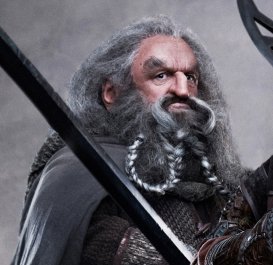 |
OriDwarf of Thorin & Company. Ori was of the line of Durin and was a remote kinsman of Thorin Oakenshield. He accompanied Thorin on the quest to reclaim the Lonely Mountain from Smaug the Dragon in 2941 of the Third Age. Ori's hood was grey and he played the flute. He wrote well and quickly in a large, bold hand and often used Elvish script.In 2989, Ori accompanied Balin on his quest to establish a colony in Moria. It was he who wrote the last passage in the Book of Mazarbul recording the Dwarves' final days in 2994. He told of the death of Balin and the slaying of Oin by the Watcher in the Water and of how they became trapped by Orcs. Ori's last words were: We cannot get out. The end comes ... drums, drums in the deep ... they are coming.Ori perished along with the rest of the Dwarves of Balin's company. Names &
Etymology:
Sources:
|
Adam Brown as Ori
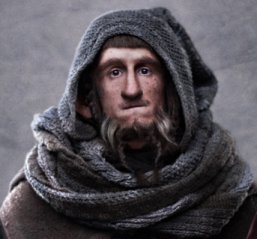 |
Telchar made the Dragon-helm for the Dwarf-lord Azaghal of Belegost sometime after the Dragon Glaurung appeared around the year 260. The Dragon-helm had the image of Glaurung on its crest and it had a visor that shielded the wearer from the Dragon's fire and enthralling gaze.
The helm was passed from Azaghal to Maedhros to Fingon and then to Hador and eventually to Turin. According to one story, Turin wore the Dragon-helm at the Battle of Tumhalad and was the only one able to withstand Glaurung, though he later fell under the Dragon's spell when he raised the visor and looked Glaurung in the eyes. Years later, Turin slew Glaurung, possibly while wearing the Dragon-helm.
Telchar also forged the knife Angrist which could cut through iron. Angrist belonged to Curufin but it was taken from him by Beren. Beren used Angrist to cut one of the Silmarils from the crown of Morgoth though the knife broke afterwards.
Narsil's original owner is not known. The sword survived several millennia until Elendil used it to battle Sauron in the War of the Last Alliance at the end of the Second Age. Narsil broke beneath Elendil but at the end of the Third Age it was reforged as Anduril, the sword of Aragorn.
Names &
Etymology:
The meaning and language of the
name Telchar is uncertain. Dwarves did not usually share their Khuzdul
- or Dwarvish - names with others and used "outer names" in other languages,
so Telchar could be Elvish in origin. There is an early Quenya word talka
meaning "smith" which could be a possible source of Telchar.
Sources:
The Two
Towers: "The King of the Golden Hall," p. 115
The Silmarillion:
"Of the Sindar," p. 94; "Of Beren and Luthien," p. 177; "Of Turin Turambar,"
p. 212-13
Unfinished
Tales: "Narn I Hin Hurin," p. 75-76, 154-55
The History
of Middle-earth, vol. I, The Book of Lost Tales Part One: "Appendix:
Names in The Lost Tales - Part One," p. 266 (Talka Marda - "Smith of the
World)
The History
of Middle-earth, vol. III, The Lays of Beleriand: "The Lay of the Children
of Hurin," p. 115, 126
The History
of Middle-earth, vol. IV, The Shaping of Middle-earth: "The Quenta,"
p. 118, 182
The History
of Middle-earth, vol. XI, The War of the Jewels: "The Grey Annals,"
p. 12, 46
Thorin I died in 2289 and was succeeded by his son Gloin. (Note: This Gloin is not the father of Gimli.)
Names &
Etymology:
Thorin means "daring" in
Old Norse, from the word thor meaning "audacity" and the verb thora
meaning "to dare." Thorin is one of the names that appears in the Old Norse
poem Voluspa. Thorin I was the
first King of that name, later followed by Thorin
II Oakenshield and Thorin III Stonehelm.
Thorin I was the leader of the Dwarves of the line of Durin and as such was called the King of Durin's Folk.
Sources:
Appendix
A of The Lord of the Rings: "Durin's Folk," p. 353 and genealogical
table p. 361
Appendix
B of The Lord of the Rings: "The Tale of Years," p. 368
Völuspá:
The Poetic Edda: Modern English translation by Bekie Marett
The
Elder Eddas and the Younger Eddas translated by I.A. Blackwell
During the War of the Ring, the Lonely Mountain was attacked by Easterlings allied with Sauron. Dain was killed in the Battle of Dale on March 17, 3019, and Thorin Stonehelm became King under the Mountain. Thorin and the Dwarves barricaded themselves in the Lonely Mountain along with the Men of Dale until they received word of Sauron's defeat. Then, on March 27, Thorin and King Bard II of Dale led their people forth from the Mountain and drove the enemy away.
Thorin Stonehelm sent an ambassador to the coronation of Aragorn, King Elessar, on May 1. The Lonely Mountain remained an independent realm under the protection of King Elessar, and they maintained friendly relations.
Names &
Etymology:
Thorin means "daring" in
Old Norse, from the word thor meaning "audacity" and the verb thora
meaning "to dare." Thorin is one of the names that appears in the Old Norse
poem Voluspa. Thorin Stonehelm was
styled Thorin III because he was the third King
of Durin's Folk of that name.
Thorin III was called King under the Mountain because he was the leader of the Dwarves who lived in the Lonely Mountain. He was also the leader of the Dwarves of the line of Durin and as such was called the King of Durin's Folk.
The origin of the nickname Stonehelm is not known.
Sources:
Appendix
A of The Lord of Rings: "Durin's Folk," genealogical table
Appendix
B of The Lord of Rings: "The Tale of Years," p. 375-76
Völuspá:
The Poetic Edda: Modern English translation by Bekie Marett
The
Elder Eddas and the Younger Eddas translated by I.A. Blackwell
Thrain went north and came to the Lonely Mountain in 1999. There he founded a new realm and became King under the Mountain. The Dwarves began new works, and they made the Great Hall of Thrain. Thrain discovered the fabulous gemstone called the Arkenstone at the root of the Lonely Mountain.
Thrain I died in 2190 and was succeeded by his son, Thorin I.
Names &
Etymology:
Thrain is one of the dwarves
named in the Old Norse poem Voluspa.
His name means "craver" or "persistent, resolute" from the verb thra
meaning "desire vehemently." Thrain I was also called Thrain the Old.
He was the King under the Mountain, meaning the Lonely Mountain.
He was also the leader of the Dwarves of the line of Durin
and as such was called the King
of Durin's Folk.
Sources:
The Hobbit:
"An Unexpected Party," p. 31; "Inside Information," p. 243
Appendix
A of The Lord of Rings: "Durin's Folk," p. 353 and genealogical table
p. 361
Appendix
B of The Lord of Rings: "The Tale of Years," p. 368
Völuspá:
The Poetic Edda: Modern English translation by Bekie Marett
The
Elder Eddas and the Younger Eddas translated by I.A. Blackwell
Thror and Thrain wandered with their small company of followers for many years. They became poor and desperate. Then in 2790, Thror left Thrain and his people in Dunland and went to Moria. Before he set out, Thror gave Thrain the last remaining of the Seven Rings of the Dwarves as well as the map and key to the secret door of the Lonely Mountain.
In Moria, Thror was slain by the Orc chieftain Azog and his corpse was defiled. When he heard the news, Thrain sat silently for seven days and then he declared war against the Orcs of the Misty Mountains. Thrain was now the King of Durin's Folk and over the next three years he gathered a large force of Dwarves from the House of Durin and from other Houses.
The War of the Dwarves and the Orcs began in 2793. The Dwarves sacked many Orc strongholds in the Misty Mountains seeking Azog. At the Battle of Azanulbizar in 2799, Thrain's forces launched an assault on Moria. The Dwarves were victorious and Azog was slain, but countless Dwarves were killed including Thrain's son Frerin. Thrain lost an eye and was wounded in the leg.
After the battle, Thrain was ready to reclaim Moria, but his kinsman Dain counselled against it, for he had looked through the East-gate and was aware that Durin's Bane, the Balrog, still dwelled there. The Dwarves dispersed and Thrain led a small following back to Dunland. They later went north to Eriador and in 2802 they settled in the Blue Mountains, where they wrought works of iron.
Although his people began to prosper, Thrain was not content. It may be that he was influenced by the Ring given to him by his father, for the Rings of the Dwarves had the power to inflame the desire for gold. On April 21, 2841, Thrain took his father's map and key and set out in the direction of the Lonely Mountain with a few followers including Balin and Dwalin.
Thrain was waylaid and pursued by Orcs, wolves, and birds under the command of Sauron, who wanted Thrain's Ring. The Dwarves wandered for years until one night in 2845, Thrain disappeared from their camp on the eaves of Mirkwood. He was taken captive and thrown into the pits of Sauron's stronghold at Dol Guldur, where he was tormented and the Ring was taken from him.
In 2850, Gandalf the Grey went to Dol Guldur to investigate the evil presence there. He found Thrain in the dungeon raving about "the last of the Seven." Thrain's mind had been broken and he could not even remember his own name. Before he died he gave Gandalf the map and key to be passed on to his son, though he could not remember Thorin's name either. Many years later, Thorin fulfilled Thrain's wish and reclaimed the Lonely Mountain.
Names &
Etymology:
Thrain is one of the dwarves
named in the Old Norse poem Voluspa.
His name means "craver" or "persistent, resolute" from the verb thra
meaning "desire vehemently." He was the leader of the Dwarves of the line
of Durin and as such was called the King of Durin's
Folk.
Sources:
The Hobbit:
"An Unexpected Party," p. 28-29, 31-35
The Fellowship
of the Ring: "The Council of Elrond," p. 281-82; "A Journey in the
Dark," p. 310
Appendix
A of The Lord of Rings: "Durin's Folk," p. 353-58 and genealogy
The Annotated
Hobbit: "The Quest of Erebor," p. 368, 371-72
Völuspá:
The Poetic Edda: Modern English translation by Bekie Marett
The
Elder Eddas and the Younger Eddas translated by I.A. Blackwell
Around 2570, Dragons from the Northern Waste began to attack the Dwarf settlements in the Grey Mountains. Thror's father Dain I and brother Fror were killed by a Cold Drake in 2589. Thror became the leader of the Dwarves of Durin's line. In 2590, he led many of his people to the Lonely Mountain, where he reestablished the realm of his forefathers and became King under the Mountain.
The Dwarves of the Lonely Mountain prospered for many years. They expanded the halls under the mountain and discovered gold and jewels, and they made many great weapons and beautiful things. The Dwarves became friendly with the Men who lived nearby in Dale, and they traded with their kinsfolk in the Iron Hills.
In 2770, Smaug the Dragon descended upon the Lonely Mountain and claimed it and its treasures for himself. Thror and his son Thrain II escaped through a secret Side-door in the mountain. They gathered other survivors including Thrain's children Thorin, Frerin, and Dis and headed south. Thror's people wandered homeless for many years. After a while they settled in Dunland on the southwestern side of the Misty Mountains.
Thror became disturbed in his mind, brooding on the treasures his people had lost. He may have been influenced by the Last of the Seven Rings of the Dwarves which was in his possession. Thror's Ring may have been responding to Sauron's growing power, causing Thror to become greedy and obsessed with acquiring wealth.
In 2790, Thror decided to go to Moria, which had once been the great Dwarf realm of Khazad-dum, but which had become a place of evil after a Balrog awoke there. He gave his Ring to his son Thrain and set out with only one companion, Nar. They crossed the Redhorn Gate into the Dimrill Dale and found the East-gate of Moria open.
Thror entered Moria alone. He was killed by the Orc chieftain Azog. The Orc cut off Thror's head and branded the name Azog on his forehead and threw the head and body out into the valley for Nar to find. Nar brought the news of Thror's death back to Thrain. The Dwarves responded by waging war against the Orcs, culminating in the defeat of the Orcs at the Battle of Azanulbizar in 2799.
Names &
Etymology:
The name Thrór appears
in the Old Norse poem Voluspa. It means
"burgeoning." He was the leader of the Dwarves of the line of Durin and
as such was called the King of
Durin's Folk.
Sources:
The Hobbit:
"An Unexpected Party," p. 28, 31-33; "A Warm Welcome," p. 205, 208-10;
"Inside Information," p. 232, 243; "Not at Home," p. 253; "Fire and Water,"
p. 266; "The Gathering of the Clouds," p. 269-70
The Fellowship
of the Ring: "The Council of Elrond," p. 254, 281-82
Appendix
A of The Lord of Rings: "Durin's Folk," p. 353-57 and genealogy
Völuspá:
The Poetic Edda: Modern English translation by Bekie Marett
